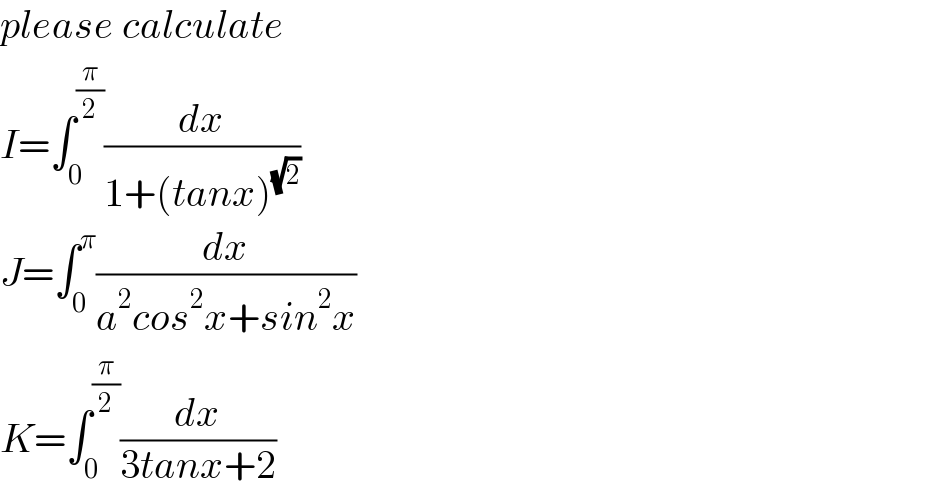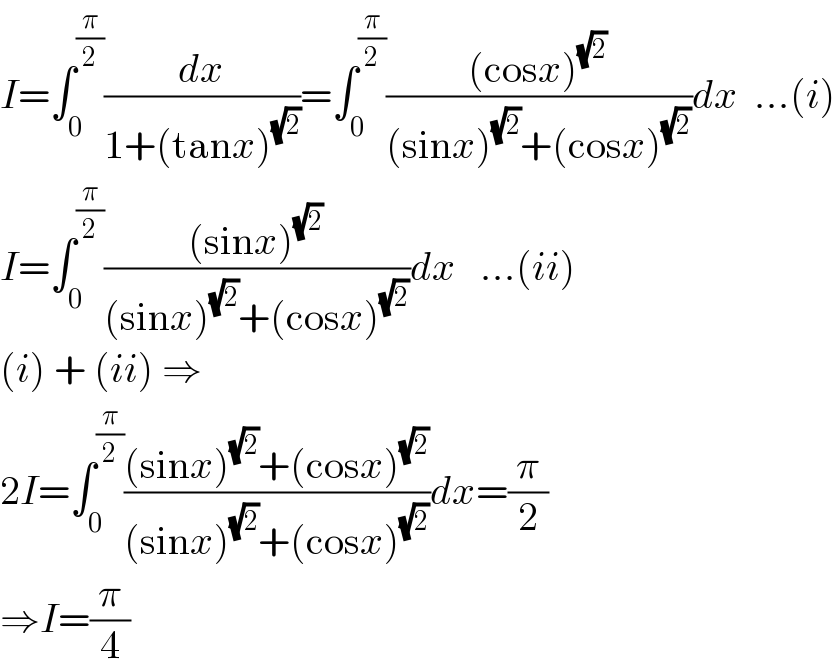
Question and Answers Forum
Question Number 175987 by stelor last updated on 10/Sep/22

Answered by Ar Brandon last updated on 10/Sep/22
![J=∫_0 ^π (dx/(a^2 cos^2 x+sin^2 x))=∫_0 ^π ((sec^2 x)/(a^2 +tan^2 x))dx =2∫_0 ^(π/2) ((d(tanx))/(a^2 +tan^2 x))=(2/a)[arctan(((tanx)/a))]_0 ^(π/2) =(π/a)](Q175988.png)
Commented by stelor last updated on 10/Sep/22

Answered by Ar Brandon last updated on 10/Sep/22

Answered by Ar Brandon last updated on 10/Sep/22

Commented by Ar Brandon last updated on 10/Sep/22

Commented by Ar Brandon last updated on 11/Sep/22
![K=∫_0 ^(π/2) (dx/(3tanx+2))=∫_0 ^1 (2/(3(((2t)/(1−t^2 )))+2))∙(dt/(1+t^2 ))=∫_0 ^1 ((t^2 −1)/(2t^2 −6t−2))∙((2dt)/(t^2 +1)) =∫_0 ^1 ((t^2 −1)/((t^2 −3t−1)(t^2 +1)))dt=(1/(13))∫_0 ^1 (((6t−9)/(t^2 −3t−1))−((6t−4)/(t^2 +1)))dt −−−−−−−−−−−−−−−−−−−−−−−−−−− ((at+b)/(t^2 −3t−1))+((ct+d)/(t^2 +1))=(((at+b)(t^2 +1)+(ct+d)(t^2 −3t−1))/((t^2 −3t−1)(t^2 +1))) a+c=^t^3 0, b−3c+d=1, a−c−3d=0, b−d=−1 lim_(t→i) ⇒(ci+d)(−2−3i)=(−2d+3c)−i(2c+3d)=−2 ⇒c=−(6/(13)), d=(4/(13)), ⇒b=−(9/(13)), a=(6/(13)) −−−−−−−−−−−−−−−−−−−−−−−−−−− =(1/(13))∫_0 ^1 ((3(2t−3))/(t^2 −3t−1))dt−(3/(13))∫_0 ^1 ((2t)/(t^2 +1))dt+(4/(13))∫_0 ^1 (1/(t^2 +1))dt =(3/(13))[ln∣t^2 −3t−1∣]_0 ^1 −(3/(13))[ln(t^2 +1)]_0 ^1 +(4/(13))[arctan(t)]_0 ^1 =(3/(13))[ln∣((t^2 −3t−1)/(t^2 +1))∣]_0 ^1 +(4/(13))((π/4))=(1/(13))ln((3/2))^3 +(π/(13)) =(1/(13))ln(((27)/8))+(π/(13))=(1/(13))(π+ln(((27)/8)))≈0,33523](Q176010.png)
Answered by a.lgnaoui last updated on 10/Sep/22
![k=∫_0 ^(π/2) (dx/(3tanx+2)) posons t=tanx x=arctant dt=(1+t^2 )dx dx=(dt/(1+t^2 )) k=∫_0 ^∞ (dt/((3t+2)(1+t^2 )))=∫_0 ^∞ (((−3t+2)/(13(1+t^2 )))+(9/(13(3t+2))))dt =−(3/(26))∫((2t−(2/3))/(1+t^2 ))dt+(9/(13))∫(dt/(3t+2)) =−(3/(26))[log(1+t^2 )]_0 ^∞ +(1/(13))∫_0 ^∞ (dt/(1+t^2 ))+(9/(13))[log(3t+2)]_0 ^∞ =((−3)/(26))[log(1+t^2 )]_0 ^∞ +(1/(13))[arctan(t)]_0 ^∞ +(9/(13))[log(3t+2)]_0 ^∞ ((−1)/(13))[log(1+t^2 )]_0 ^∞ +(9/(13))[log(3t+2)]_0 ^∞ +(π/(26)) =log[((((3t+2)^(9/(13)) )/((1+t^2 )^(1/(13)) )))]_0 ^∞ +(π/(26)) t=0 (((3t+2)^(9/(13)) )/((1+t)^(1/(13)) )) =2^(9/(13)) t→∞ ((3t^(9/(13)) (1+(2/t))^(9/(13)) )/(t^(1/(13)) (1+(1/t))^(1/(13)) ))=3^(9/(13)) t^(8/(13)) k=(9/(13))log((3/2))+(π/(26))+(8/(13)) lim_(t→∞) (logt) k=+∞](Q176006.png)
